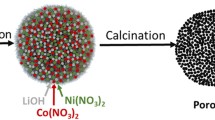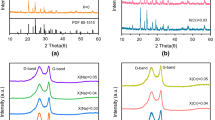Abstract
Lithium-rich layered oxides always suffer from low initial Coulombic efficiency, poor rate capability and rapid voltage fading. Herein, engineering oxygen vacancies in hierarchically Li1.2Mn0.54Ni0.13Co0.13O2 porous microspheres (L@S) is carried out to suppress the formation of irreversible Li2O during the initial discharge process and improve the Li+ diffusion kinetics and structural stability of the cathode mateiral. As a result, the prepared L@S cathode delivers high initial Coulombic efficiency of 92.3% and large specific capacity of 292.6 mA h g−1 at 0.1 C. More importantly, a large reversible capacity of 222 mA h g−1 with a capacity retention of 95.7% can be obtained after 100 cycles at 10 C. Even cycled at ultrahigh rate of 20 C, the L@S cathode can deliver stable reversible capacity of 153 mA h g−1 after 100 cycles. Moreover, the full cell using L@S as cathode and Li4Ti5O12 as anode exhibits a relatively high reversible capacity of 141 mA h g−1 with an outstanding voltage retention of 97% after 400 cycles at a large current density of 3 C. These results may shed light on the improvement of electrochemical performances of lithium-rich layered oxides via the multiscale coordinated design based on atomic defects, microstructure and composition.
摘要
富锂锰基正极材料存在首次库仑效率低、 倍率性能差以及电压衰减严重等问题, 极大地限制了其规模化应用. 本文通过在富锂锰基分级多孔微米球的表面构筑氧空位(L@S)成功抑制了首次放电过程中不可逆Li2O的形成, 有效促进了Li+离子的扩散动力学, 从而提高了电极材料的结构稳定性. 研究结果表明, L@S正极在0.1 C电流密度下循环的首次库仑效率高达92.3%, 放电比容量为292.6 mA h g−1; 在10 C大电流密度下循环100圈后可逆比容量为222 mA h g−1, 容量保持率为95.7%. 进一步增大电流密度至20 C时, 循环100圈后L@S正极的放电比容量仍高达153 mA h g−1. 此外, 匹配Li4Ti5O12负极组装的全电池在3 C电流密度下循环400圈后的可逆比容量为141 mA h g−1, 电压保持率高达97%.
Similar content being viewed by others
References
Goodenough JB, Kim Y. Challenges for rechargeable Li batteries. Chem Mater, 2010, 22: 587–603
Tarascon JM, Armand M. Issues and challenges facing rechargeable lithium batteries. Nature, 2001, 414: 359–367
Xi LJ, Wang HE, Lu ZG, et al. Facile synthesis of porous LiMn2O4 spheres as positive electrode for high-power lithium ion batteries. J Power Sources, 2012, 198: 251–257
Wang G, Liu H, Liu J, et al. Mesoporous LiFePO4/C nano-composite cathode materials for high power lithium ion batteries with superior performance. Adv Mater, 2010, 22: 4944–4948
Shi JL, Xiao DD, Ge M, et al. High-capacity cathode material with high voltage for Li-ion batteries. Adv Mater, 2018, 30: 1705575
Yu H, Zhou H. High-energy cathode materials (Li2MnO3—LiMO2) for lithium-ion batteries. J Phys Chem Lett, 2013, 4: 1268–1280
Wang J, He X, Paillard E, et al. Lithium- and manganese-rich oxide cathode materials for high-energy lithium ion batteries. Adv Energy Mater, 2016, 6: 1600906
Yabuuchi N, Yoshii K, Myung ST, et al. Detailed studies of a high-capacity electrode material for rechargeable batteries, Li2MnO3—LiCo1/3Ni1/3Mn1/3O2. J Am Chem Soc, 2011, 133: 4404–4419
Yu X, Lyu Y, Gu L, et al. Understanding the rate capability of high-energy-density li-rich layered Li1.2Ni0.15Co0.1Mn0.55O2 cathode materials. Adv Energy Mater, 2014, 4: 1300950
Chen M, Chen D, Liao Y, et al. Layered lithium-rich oxide nanoparticles doped with spinel phase: Acidic sucrose-assistant synthesis and excellent performance as cathode of lithium ion battery. ACS Appl Mater Interfaces, 2016, 8: 4575–4584
Qiu B, Yin C, Xia Y, et al. Synthesis of three-dimensional nanoporous Li-rich layered cathode oxides for high volumetric and power energy density lithium-ion batteries. ACS Appl Mater Interfaces, 2017, 9: 3661–3666
Zhang Y, Zhang W, Shen S, et al. Hollow porous bowl-shaped lithium-rich cathode material for lithium-ion batteries with exceptional rate capability and stability. J Power Sources, 2018, 380: 164–173
Chen Z, Yan X, Xu M, et al. Building honeycomb-like hollow microsphere architecture in a bubble template reaction for high-performance lithium-rich layered oxide cathode materials. ACS Appl Mater Interfaces, 2017, 9: 30617–30625
Cai Y, Huang SZ, She FS, et al. Facile synthesis of well-shaped spinel LiNi0.5Mn1.5O4 nanoparticles as cathode materials for lithium ion batteries. RSC Adv, 2016, 6: 2785–2792
Yan P, Zheng J, Zhang X, et al. Atomic to nanoscale investigation of functionalities of an Al2O3 coating layer on a cathode for enhanced battery performance. Chem Mater, 2016, 28: 857–863
Zhang X, Belharouak I, Li L, et al. Structural and electrochemical study of Al2O3 and TiO2 coated Li1.2Ni0.13Mn0.54Co0.13O2 cathode material using ALD. Adv Energy Mater, 2013, 3: 1299–1307
Zhang S, Gu H, Tang T, et al. In situ encapsulation of the nanoscale Er2O3 phase to drastically suppress voltage fading and capacity degradation of a Li- and Mn-rich layered oxide cathode for lithium ion batteries. ACS Appl Mater Interfaces, 2017, 9: 33863–33875
Zheng F, Yang C, Xiong X, et al. Nanoscale surface modification of lithium-rich layered-oxide composite cathodes for suppressing voltage fade. Angew Chem Int Ed, 2015, 54: 13058–13062
Sun S, Yin Y, Wan N, et al. AlF3 surface-coated Li[Li0.2Ni0.17 Co0.07Mn0.56]O2 nanoparticles with superior electrochemical performance for lithium-ion batteries. ChemSusChem, 2015, 8: 2544–2550
Liu J, Hou M, Yi J, et al. Improving the electrochemical performance of layered lithium-rich transition-metal oxides by controlling the structural defects. Energy Environ Sci, 2014, 7: 705–714
Xie Q, Liu P, Zeng D, et al. Dual electrostatic assembly of graphene encapsulated nanosheet-assembled ZnO-Mn-C hollow micro-spheres as a lithium ion battery anode. Adv Funct Mater, 2018, 28: 1707433
Qiu B, Zhang M, Wu L, et al. Gas-solid interfacial modification of oxygen activity in layered oxide cathodes for lithium-ion batteries. Nat Commun, 2016, 7: 12108
Wang G, Yi L, Yu R, et al. Li1.2Ni0.13Co0.13Mn0.54O2 with controllable morphology and size for high performance lithium-ion batteries. ACS Appl Mater Interfaces, 2017, 9: 25358–25368
Zhang H, Wang J, Liu Q, et al. Extracting oxygen anions from ZnMn2O4: Robust cathode for flexible all-solid-state Zn-ion batteries. Energy Storage Mater, 2018
Ji Y, Li R, Mu D, et al. Surface modification of Li1.2Mn0.56Ni0.16 Co0.08O2 cathode material by supercritical CO2 for lithium-ion batteries. J Electrochem Soc, 2018, 165: A2880–A2888
Liu D, Wang C, Yu Y, et al. Understanding the nature of ammonia treatment to synthesize oxygen vacancy-enriched transition metal oxides. Chem, 2019, 5: 376–389
Xu M, Fei L, Zhang W, et al. Tailoring anisotropic Li-ion transport tunnels on orthogonally arranged Li-rich layered oxide nanoplates toward high-performance Li-ion batteries. Nano Lett, 2017, 17: 1670–1677
Liu D, Zhang C, Yu Y, et al. Hydrogen evolution activity enhancement by tuning the oxygen vacancies in self-supported mesoporous spinel oxide nanowire arrays. Nano Res, 2017, 11: 603–613
Zhang L, Wang W, Jiang D, et al. Photoreduction of CO2 on BiOCl nanoplates with the assistance of photoinduced oxygen vacancies. Nano Res, 2014, 8: 821–831
Yu Y, Shi Y, Zhang B Synergetic transformation of solid inorganic-organic hybrids into advanced nanomaterials for catalytic water splitting. Acc Chem Res, 2018, 51: 1711–1721
Zhang XD, Shi JL, Liang JY, et al. Suppressing surface lattice oxygen release of Li-rich cathode materials via heterostructured spinel Li4Mn5O12 coating. Adv Mater, 2018, 30: 1801751
Baddour-Hadjean R, Pereira-Ramos JP. Raman microspectrometry applied to the study of electrode materials for lithium batteries. Chem Rev, 2010, 110: 1278–1319
Zhao J, Huang R, Gao W, et al. An ion-exchange promoted phase transition in a Li-excess layered cathode material for high-performance lithium ion batteries. Adv Energy Mater, 2015, 5: 1401937
Yu R, Zhang X, Liu T, et al. Spinel/layered heterostructured Lithium-rich oxide nanowires as cathode material for high-energy lithium-ion batteries. ACS Appl Mater Interfaces, 2017, 9: 41210–41223
Fell CR, Qian D, Carroll KJ, et al. Correlation between oxygen vacancy, microstrain, and cation distribution in lithium-excess layered oxides during the first electrochemical cycle. Chem Mater, 2013, 25: 1621–1629
Xu M, Lian Q, Wu Y, et al. Li+-conductive Li2SiO3 stabilized Lirich layered oxide with an in situ formed spinel nano-coating layer: Toward enhanced electrochemical performance for lithium-ion batteries. RSC Adv, 2016, 6: 34245–34253
Xiao Z, Meng J, Li Q, et al. Novel MOF shell-derived surface modification of Li-rich layered oxide cathode for enhanced lithium storage. Sci Bull, 2018, 63: 46–53
Yu FD, Que LF, Wang ZB, et al. Controllable synthesis of hierarchical ball-in-ball hollow microspheres for a high performance layered Li-rich oxide cathode material. J Mater Chem A, 2017, 5: 9365–9376
Pang S, Xu K, Wang Y, et al. Enhanced electrochemical performance of Li-rich layered cathode materials via chemical activation of Li2MnO3 component and formation of spinel/carbon coating layer. J Power Sources, 2017, 365: 68–75
Kim S, Cho W, Zhang X, et al. A stable lithium-rich surface structure for lithium-rich layered cathode materials. Nat Commun, 2016, 7: 13598
Li X, Zhang K, Mitlin D, et al. Fundamental insight into Zr modification of Li- and Mn-rich cathodes: Combined transmission electron microscopy and electrochemical impedance spectroscopy study. Chem Mater, 2018, 30: 2566–2573
Yu R, Zhang X, Liu T, et al. Hierarchically structured lithium-rich layered oxide with exposed active {010} planes as high-rate-capability cathode for lithium-ion batteries. ACS Sustain Chem Eng, 2017, 5: 8970–8981
Pei Y, Xu CY, Xiao YC, et al. Phase transition induced synthesis of layered/spinel heterostructure with enhanced electrochemical properties. Adv Funct Mater, 2017, 27: 1604349
Li X, Qiao Y, Guo S, et al. Direct visualization of the reversible O2−/O− redox process in Li-rich cathode materials. Adv Mater, 2018, 30: 1705197
Acknowledgements
The authors acknowledge the support from the National Key R&D Program of China (2016YFA0202602 and 2016YFA0202604), the National Natural Science Foundation of China (51701169 and 51871188), the Natural Science Foundation of Fujian Province (2017J05087), the Key Projects of Youth Natural Foundation for the Universities of Fujian Province of China (JZ160397), and the “Double-First Class” Foundation of Materials and Intelligent Manufacturing Discipline of Xiamen University.
Author information
Authors and Affiliations
Contributions
Author contributions Cai Y and Ku L designed the materials; Cai Y, Ma Y and Zheng H performed the experiments; Han J and Xu W analyzed the data; Cai Y wrote the paper with support from Wang L and Xie Q; Peng DL, Xie Q, Chen Y and Qu B contributed to the theoretical analysis. All authors contributed to the general discussion.
Corresponding authors
Additional information
Conflict of interest The authors declare no conflict of interest.
Yuxin Cai received his BE degree from the Department of Materials Science and Engineering, Shandong University. Currently, he is a ME candidate at the Department of Materials Science and Engineering in Xiamen University under the supervision of Prof. Lai-Sen Wang. His research focuses on the design and synthesis of high-performance cathode materials for lithium ion batteries.
Lai-Sen Wang is an Associated Professor in the Department of Materials Science and Engineering, College of Materials, Xiamen University. He received his PhD degree in materials physics and chemistry at Xiamen University in 2012. His research focuses on the electromagnetic transport property of thin films and the design and synthesis of nanocomposite materials for energy storage.
Qingshui Xie is an Associated Professor in the College of Materials, Xiamen University. He got his BSc and MSc degrees from Lanzhou University in 2009 and 2012, respectively. After that, he moved to Xiamen University as a PhD candidate and received his PhD degree in materials physics and chemistry in 2015. His research interest concentrates on the advanced electrode materials for high-performance lithium ion batteries.
Dong-Liang Peng received his BSc (1983), MSc (1989) and PhD (1997) degrees in condensed matter physics from Lanzhou University. He received another PhD degree in materials science and engineering from Nagoya Institute of Technology (Japan) in 2002. Currently he is a Professor in the College of Materials, Xiamen University. He received the National Natural Science Fund for Distinguished Young Scholars. His research focuses on the nano functional materials, and their applications in catalysis, energy storage and electromagnetics.
Electronic supplementary material
40843_2019_9456_MOESM1_ESM.pdf
Engineering oxygen vacancies in hierarchically porous Li-rich layered oxide microspheres for high-rate lithium ion battery cathode
Rights and permissions
About this article
Cite this article
Cai, Y., Ku, L., Wang, L. et al. Engineering oxygen vacancies in hierarchically Li-rich layered oxide porous microspheres for high-rate lithium ion battery cathode. Sci. China Mater. 62, 1374–1384 (2019). https://doi.org/10.1007/s40843-019-9456-1
Received:
Accepted:
Published:
Issue Date:
DOI: https://doi.org/10.1007/s40843-019-9456-1




